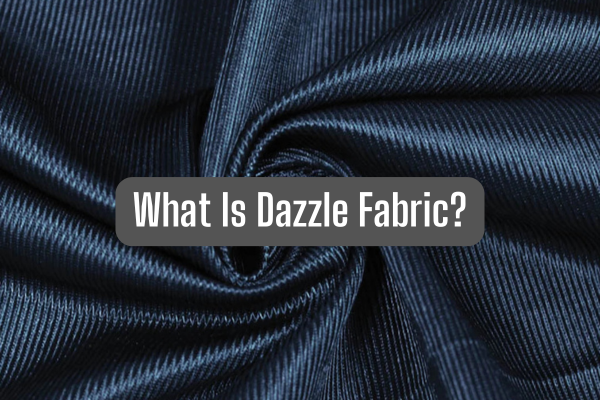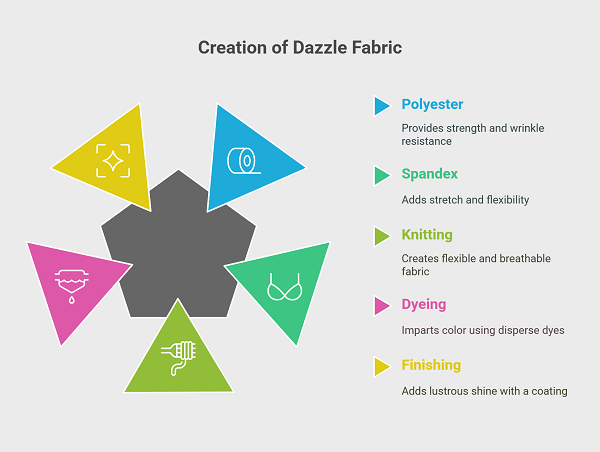What Is Dazzle Fabric?

A Quick Definition
Dazzle fabric is a type of synthetic textile, mostly made from polyester, known for its shiny finish and grid-like texture. It often appears in sports jerseys, cheerleading outfits, and flashy dancewear. You’ve probably seen it before without knowing its name.
The Shimmer Behind the Name
The word dazzle isn’t random—it reflects exactly what this fabric does. Under bright lights, it glimmers like a disco ball in motion. It’s not just for looks though. It’s built to perform.
Table of Contents
How Is Dazzle Fabric Made?

The Materials Used
Polyester is the primary ingredient. Why? Because it’s strong, resists shrinking, and doesn’t wrinkle. Add a little spandex if stretch is needed.
The Manufacturing Process
Knitting vs Weaving
Dazzle fabric is knit, not woven. That’s important. Knitted fabrics stretch better and feel more flexible. They’re also lighter and more breathable.
Dyeing and Finishing
After knitting, it gets dyed. Manufacturers use disperse dyes for polyester. Then comes the real magic—the finish. A lustrous coating adds the iconic shine.
Where Is Dazzle Fabric Used?
Sportswear’s Favorite Pick
Dazzle fabric and sports jerseys go hand-in-hand. About 60% of budget athletic uniforms use dazzle fabric. It’s common in school and amateur team kits.
Why Athletes Love It
It’s light. It doesn’t trap heat. It allows free movement. And it looks good on camera—perfect for televised matches or social media posts.
Dancewear and Costumes
Here’s where the name shines—literally. Dazzle fabric reflects stage lights beautifully, making every move look 10x flashier.
Lights, Movement, Dazzle!
You’ve seen those halftime shows and Broadway costumes that sparkle like crazy? Yup, that’s dazzle. Its reflective surface catches even low light and makes dancers pop.
Promotional Apparel and Accessories
Companies love using dazzle fabric for giveaways or brand wear. It’s eye-catching and easy to print logos on.
Key Characteristics of Dazzle Fabric

Shiny but Practical
It isn’t just a pretty face. Dazzle fabric is water-resistant, snag-resistant, and holds up after many washes.
Lightweight Yet Durable
A square yard of dazzle fabric weighs about 4–6 ounces. That’s lighter than cotton, but it won’t tear easily.
Easy to Print On
Its smooth surface allows clean screen printing. Sublimation also works well. This makes it ideal for team logos or custom messages.
Pros and Cons of Dazzle Fabric

Why People Choose It
- Lightweight (great for mobility)
- Moisture-wicking (ideal for sports)
- Shine and style (adds flair to any garment)
- Cost-effective (cheaper than high-end sports fabrics)
The Downside
- Not the most breathable in extreme heat
- Can feel plasticky to sensitive skin
- Shine may fade after 30+ washes
How to Care for Dazzle Fabric
Washing Tips
- Use cold water
- Avoid bleach
- Gentle cycle is your friend
- Air dry if possible
Storage Suggestions
- Fold, don’t hang (avoids stretching)
- Keep away from sunlight (prevents fading)
- Store in a dry place
Final Thoughts: Is Dazzle Fabric Worth It?
Absolutely—if you’re looking for something functional, flashy, and affordable. Dazzle fabric isn’t high fashion, but it plays its role well. Whether you’re designing a team uniform, a dance costume, or promotional wear, it does the job—and looks good doing it.
It’s not for everyone. If you want soft, breathable fabric for long wear, it might not be your best choice. But for short bursts of impact, it delivers more dazzle than you’d expect from a piece of polyester.
FAQs
1. What makes dazzle fabric different from mesh?
Mesh has open holes and is more breathable. Dazzle is smoother, shinier, and denser.
2. Can I sew dazzle fabric at home?
Yes, but use a ballpoint needle and polyester thread. And don’t forget to pin carefully—it can slide!
3. Is dazzle fabric good for summer?
Not ideal for extreme heat. It’s moisture-wicking, but not super breathable like cotton mesh.
4. Can you iron dazzle fabric?
Low heat only. Better yet—don’t. Steam or hang it in the bathroom during a hot shower.
5. How long does dazzle fabric last?
With gentle care, around 3–5 years of active use. For occasional wear, much longer.
